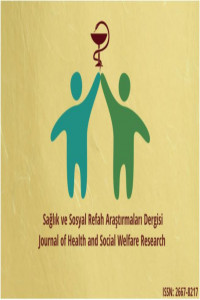An Investigation on Innovative Application in Hospitals Affiliated with Public Health Sector of Metropolitan City of Istanbul
hospital, communication, organizational structure, innovation, public
An Investigation on Innovative Application in Hospitals Affiliated with Public Health Sector of Metropolitan City of Istanbul
organizational structure, Innovation, public, hospital, communication,
___
- REFERENCES 1. Koçel T. 2014, İşletme yöneticiliği, Beta Yayınları, 15. baskı. 2. Freeman C, Soete L. 2003, Yenilik iktisadı, Tübitak Yayınları, Akademik Dizi, Ankara. 3. Demirkaya H, Zengin R. Hizmet İnovasyonu ve Bir Uygulama Örneği, Elektronik Mesleki Gelişim ve Araştırma Dergisi (Ejoir) 2014;2(1). 4. Drucker P, Maciariello JA. Optimist Yayınları, 2009 Yönetim. 5. Oslo Kılavuzu (Yenilik Verilerinin Toplanması ve Yorumlanması için İlkeler). (2005), 3. baskı, Ankara Tübitak. 6. Freeman C, Soete L. 2003. Yenilik iktisadı. (Çev. E. Türkcan), Ankara, Tübitak. 7. OECD Oslo Manual, 1997, s.16 8. Kegerreis WRJ. Technological innovation and marketing management: Implications for corporate policy. Journal of Marketing 1969;33(4):3-9. 9. Drucker P. The discipline of innovation, Harvard Business Review, November-December, 1998. Url: Http://Www. Director. Co. 10. OECD ve AVRUPA BİRLİĞİ 2005. Oslo Klavuzu. Yenilik Verilerinin Toplanması ve Yorumlanması İçin İlkeler, Üçüncü Baskı, Ekonomik İşbirliği ve Kalkınma Örgütü Avrupa Birliği İstatistik Ofisi, Ankara. 11. Ahmed AM, Abdalla HS. The role of innovation process in crafting the vision of the future, computers & industrial engineering, 1999;37(1-2):421. 12. Kavrakoğlu İ. Yönetimde devrimin rehberi, inovasyon Altedo Yayıncılık, İstanbul, 2006.13. Elçi Ş. İnovasyon kalkınmanın ve rekabetin anahtarı, Nova Basın Yayın Dağıtım, Ankara, 2006. 14. Aas TH, Pedersen PE. The impact of service innovation on firm-level financial performance, The Service Industry Journal 2010;31(1):1-20. 15. Johne A. Successful market innovation, European Journal of International Management, 1999;2(1):6-11. 16. Çetin G. İnovasyon, 2009. Http://Www.Guvencetin. Com/İnovasyon/İndex.Php, Erişim Tarihi:22.11.2013).17. Vıcır S. Yenilik çeşitleri, Url Adresi: Httpparibus.Tr. Googlepages.Coms_Vicir.Pdf, (Nisan 2008)), 2007. 18. Taşkıran 2004 Alıntı Yaptım Şundan: İnovasyon Yönetimi: Çukurova Bölgesinde Faaliyet Gösteren Şirketlerde İnovasyon Uygulamalarının Tespitine Yönelik Bir Araştırma, Hasan Çeliktaş, Çukurova Üniversitesi, Sosyal Bilimler Enstitüsü İşletme Anabilim Dalı, Çukurova Üniversitesi Sosyal Bilimler Enstitüsü İşletme Anabilim Dalı, Yüksek Lisans Tezi, Adana, 2008. 19. Pfister J. Managing organizational culture for effective internal control. Berlin: Physica-Verlag, 2009. http://dx.doi.org/10.1007/978-3-7908-2340-0 20. Uzkurt C, Şen R. Örgüt kültürü ve örgütsel yeniliğin pazarlama yeniliğine etkisi: Gazlı içecek sektöründe bir araştırma. Anadolu Üniversitesi Sosyal Bilimler Dergisi 2012;12(3):27-50. 21. Tushman ML, O’reilly CA. Winning through innovation: A practical guide to leading organizational change and renewal. Massachusetts: Harvard Business Review Press, 1997:111. 22. Schein EH. Organizational Culture and Leadership, (2nd Edition). San Francisco: Jossey-Bass Publishers, 1992. 23. Kelley B. Stoking your innovation bonfire. New Jersey: John Wiley&Sons, 2010. 24. Durğun S. Örgüt kültürü ve örgütsel iletişim, Yüzüncü Yıl Üniversitesi Eğitim Fakültesi Dergisi 2006;3(2).25. Çeliktaş H. İnovasyon yönetimi: Çukurova bölgesinde faaliyet gösteren şirketlerde inovasyon uygulamalarının tespitine yönelik bir araştırma. Hasan Çeliktaş Yüksek Lisans Tezi, Çukurova Üniversitesi Sosyal Bilimler Enstitüsü İşletme Anabilim Dalı, Adana, 2008. 26. Ada N. Örgütsel iletişim ve yeni bilgi teknolojileri, Örgütsel iletişim ağları, Ege Akademik Bakış Dergisi Sayı 7, 2007. 27. Bozkurt Ö, Taşçıoğlu H. Kobilerde inovasyon çalışmaları ve örnekleri üzerine bir inceleme, Akademik Bakış Uluslar Arası Hakemli Sosyal Bilimler E-Dergisi Sayı: 11, 2007. 28. Yataklı Tedavi Kurumları İşletme Yönetmeliği, 1983.29. Damanpour F. Organisational innovation: A metaanalysis of effects of determinants and moderators. Academy of Management Journal 1991;34(3):555-90. http://dx.doi.org/10.2307/256406 30. Arslanhan Memiş S. Son dönemdeki sağlık harcamalarının analizi, Tepav Yaşam Bilimleri ve Sağlık Politikası Enstitüsü, Kasım 2012. 31. Sağlık Harcamaları İstatistikleri, 2014 E.T. http://www. tuik.gov.tr/PreHaberBultenleri.do?id=18853 32. Demirci AE. Yenilik yönetimi (Ed: Uzkurt C ve Demirci AE), TC Anadolu Üniversitesi Yayınları, Eskişehir, 2011 (Ds.Anadolu.Edu.Tr/Ekitap/Isy203u. Pdf) ET:15.01.2015. 33. Http://Www.Algoritmaconsulting.Com/Makale.Asp?Id=32. 34. Afuah A. Innovation management: Strategies, implementation, and profits. (2nd. ed.). NY: Oxford University Pres, 2003:s.94-95 35. Berger C, Piller F. Customers as co-designers: The Adidas Mass Customization Strategy, Iee Manufacturing Engineer 2003;82, 4 (Agustos):42-6.36. Kayakutlu G. Müşteri işbirliğinde yenilikçilik, V. Ulusal Üretim Araştırmaları Sempozyumu, İstanbul Ticaret Üniversitesi, 25-27 Kasım 2005.37. Burns T, Stalker G. The management of innovation. London: Tavistock, 1961. 38. Zaltman G, Duncan R, Holbeck J. Innovations and Organizations. New York: Wiley & Sons, 1973. 39. Http://Www.Kolayaof.Com/Ornek_Ozet/%C4%B0% C5%9ey203u.Pdf 40. Gümüşlüoğlu L. İnovasyon ve liderlik, savunma sanayi gündemi, Bilkent Üniversitesi İşletme Fakültesi, 2009. 41. Tidd J, Bessant J, Pavitt K. Managing innovation: integrating technological, Market and Organizational Change, Wiley, 2005. 42. Ekinci G, Bakır İ. Evaluation of publications on cardiovascular and peripheral vascular diseases within the frame of scientific publication indicators, İstanbul Cardiovascular Research Journal, 2015.
- Yayın Aralığı: Yılda 2 Sayı
- Başlangıç: 2018
- Yayıncı: Haşim ÇAPAR
Bünyamin ÖZGÜLEŞ, Şerafettin SEVİM, Suzan URGAN
Ameliyathane Hemşirelerinin Sorunlarını İnceleyen Nitel Bir Araştırma
Ali ARSLANOĞLU, Canan Elvan KÖSER
SAĞLIK BİLİMLERİ FAKÜLTESİ ÖĞRENCİLERİNİN TIBBİ HATA TUTUMLARININ BELİRLENMESİ
Fadime ÇINAR, Esra PAMUK, Enes Faruk ULUSOY, Mustafa YILMAZ
ORTODONTİK PEKİŞTİRME TEDAVİSİNDE MALİYET ANALİZİ: ESSİX – SABİT RETAİNER KARŞILAŞTIRMASI
